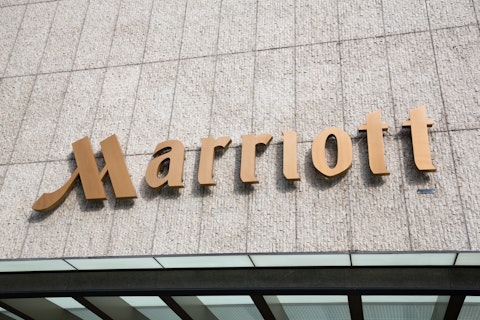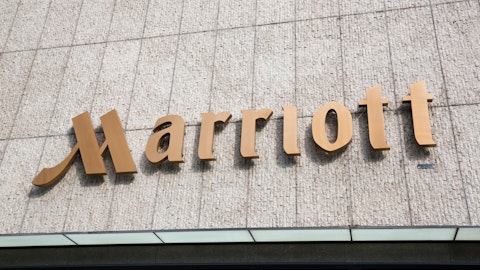Marriott International, Inc. (NASDAQ:MAR) Q2 2023 Earnings Call Transcript August 1, 2023
Marriott International, Inc. misses on earnings expectations. Reported EPS is $1.8 EPS, expectations were $2.17.
Operator: Good day, everyone, and welcome to today’s Marriott International Q2 2023 Earnings Call. At this time, all participants are in a listen-only mode. Later, you will have the opportunity to ask questions during the question-and-answer session period. [Operator Instructions] Please note, this call may be recorded. I will be standing by should you need any assistance. It is now my pleasure to turn today’s call over to Jackie McConagha, Senior Vice President of Investor Relations. Please go ahead.
Jackie McConagha: Thank you. Hello, and welcome to Marriott’s second quarter 2023 earnings call. On the call with me today are Tony Capuano, our President and Chief Executive Officer; Leeny Oberg, our Chief Financial Officer and Executive Vice President, Development; and Betsy Dahm, our Vice President of Investor Relations. Before we begin, I would like to remind everyone that many of our comments today are not historical facts and are considered forward-looking statements under federal securities laws. These statements are subject to numerous risks and uncertainties as described in our SEC filings, which could cause future results to differ materially from those expressed in or implied by our comments. Please also note that, unless otherwise stated, our RevPAR occupancy and average daily rate comments reflect system-wide constant currency results for comparable hotels.
Statements in our comments and the press release we issued earlier today are effective only today and will not be updated as actual events unfold. You can find our earnings release and reconciliations of all non-GAAP financial measures referred to in our remarks today on our Investor Relations website. Now, I will turn the call over to Tony.
Tony Capuano: Thanks, Jackie, and thank you all for joining us today. Our terrific second quarter results demonstrate the strength of global lodging demand and the success of our growth strategies. I’ve experienced a robust demand for lodging firsthand as I’ve been on the road a lot this year and have had the privilege of visiting every one of our regions. It has been wonderful to spend time with our team of hard-working and dedicated associates at properties around the world and to see how quickly global travel has rebounded. Second quarter worldwide RevPAR rose 13.5% versus the 2022 quarter, led by another quarter of meaningful recovery in Greater China. Less than two quarters after travel restrictions were lifted, RevPAR in Greater China has now surpassed 2019 levels, primarily due to the surge in domestic demand.
Worldwide occupancy in the quarter reached 72%, five percentage points higher than the year ago quarter. With our unwavering focus on maximizing revenues, global ADR grew 6% year-over-year. Global leisure demand and ADR remained robust. Second quarter leisure transient room nights and ADR each increased 5% year-over-year, yielding 10% revenue growth. In the US and Canada, leisure revenues rose 1% above last year’s sensational second quarter. Demand in this market has been stabilizing on a year-over-year basis with travelers from the region increasingly taking vacations overseas now that pandemic-related travel restrictions are behind us. Leisure room nights from the US and Canadian travelers jumped 90% in Asia Pacific and over 20% in Europe compared to the same period last year.
The group segment had another great quarter with revenues in the US and Canada growing 10% year-over-year, driven by both rate and occupancy. Group revenues are expected to remain strong going forward. At the end of June, group revenue for the back half of 2023 was pacing up 11% to last year. Meeting planners are beginning to book further out, a trend we’re also seeing with transient customers. Group revenue for full year 2024 was pacing up 14% year-over-year at the end of the quarter, an improvement from up 9% just three months prior. Recovery in business transient demand remained slow, but steady with demand from our top corporate accounts progressing modestly in the quarter. In the US and Canada, ADR again rose nicely compared to 2022, thanks to high single-digit special corporate rate increases.
This led to business transient revenues rising 12% year-over-year. Overall, cross-border travel demand also rose again in the quarter, primarily driven by an increase in international visitors to the Asia-Pacific region. The percent of total room nights from cross-border guests is now roughly one percentage point below 2019 levels of approximately 20%. Prior to the pandemic, international visitors accounted for nearly one quarter of room nights in Greater China. With the region’s international airlift still only around 40% of 2019 capacity at the end of the second quarter, we believe there is still meaningful growth opportunity in and from Greater China. We remain keenly focused on strengthening our powerful Marriott Bonvoy loyalty program, which has over 186 million members.
To further build engagement, we continued to enrich the platform with an enhanced booking experience, more choices for customers, and complementary products that drive more value and capture share of wallet, such as our co-branded credit cards and travel insurance. Our international credit cards had a record quarter, driving global card acquisitions up 25% and global card spend up 10% versus the year ago quarter. We are increasingly leveraging technology to enhance the guest experience, to drive profitability for our owners and to simplify processes for our associates. As we’ve mentioned previously, we are in the process of a major global transformation of our digital and core technology. We will be launching new reservations, loyalty and property management platforms over the next several years and look forward to the numerous capabilities these new systems will offer our key constituents.
As we focus on paths for growth, we are adding new offerings and experiences in segments where we believe there is strong consumer interest beyond our current brands. A great example is our recent announcement of an exclusive 20-year strategic license agreement with MGM Resorts International and the creation of MGM Collection with Marriott Bonvoy. The collection, which will launch beginning in October, encompasses 17 resorts with 40,000 rooms. This deal will provide us with significant presence in Las Vegas, one of the most popular destinations in the country with fantastic properties like Bellagio, the MGM Grand, and ARIA, as well as additional distribution in five other key US cities. Beyond just hotels, our strategic agreement with MGM will also give our members access to more sports, music, culinary and entertainment experiences.
We also recently announced our plans of new affordable mid-scale extended stay offering in the U.S. and Canada. Our deep experience and leading position in extended-stay lodging, coupled with the recent trends toward increased work flexibility and longer stay travel, make us very optimistic about our growth potential. While it is still early days, initial interest from the development community has been extraordinary. We are working on several hundred deals and hope to have our first deal signed by the end of this year. In the Caribbean and Latin America, we’re very excited about the recent addition of City Express to our brand lineup. These mid-scale properties have started to join our distribution channels, and we are thrilled with the noticeable uplift in conversion rates, ADR and bookings so far.
Our development team remains focused on driving conversions, especially multiunit opportunities, and interest from owners remains robust. In the first half of this year, convergence accounted for 21% of our organic room additions, including MGM, and conversions represented 63% of our organic signings through June. The MGM rooms entering our system beginning this fall will boost our rooms distribution in 2023 by 2.4%. With more than half the year behind us, we have refined our full year net rooms growth expectations to 6.4% to 6.7%. Driving valuable global growth is a top company priority, and we are very pleased with the strong rate at which we expect our industry-leading system to grow this year. We look forward to sharing more about many key aspects of our business, including our broad global portfolio of over 30 brands, their exciting growth prospects all over the world, Marriott Bonvoy, the brand that brings it all together, our technology transformation and our multiyear financial model at our Investor Day on September 27.
Now I’ll hand the call over to Leeny to discuss our second quarter financial results in more detail as well as our updated outlook for 2023. Leeny?
Leeny Oberg: Thank you, Tony. Our strong second quarter results reflected solid demand in ADR growth around the world with Greater China RevPAR more than doubling, international RevPAR rose an impressive 39% over the 2022 second quarter. Occupancy for our international regions reached 68%, a 12 percentage point improvement versus the prior year quarter and ADR increased 14%. RevPAR in the U.S. and Canada grew 6% versus the year ago quarter. Occupancy reached 74%, up 1 percentage point, while ADR increased 4%. While demand from both business and leisure guests remained strong, growth rates are stabilizing as we return to more normalized year-over-year comparisons. Total company’s gross fee revenues totaled $1.25 billion, rising 16%, led by meaningful growth in incentive management fees or IMF.
IMF totaled $193 million in the quarter, with fees in Greater China up significantly, given the strong recovery in that region. Impressively, our IMF in the first half of 2023 were 19% higher than peak IMF in the first half of 2018. Our owned, leased and other revenue net of direct expenses grew 24% despite lower termination fees, largely due to improved performance at our owned and leased hotels. Our strong IMF and owned, leased performance demonstrate our operating team’s terrific work at driving profitability. Corporate G&A rose to 4%, well-above the rate of top line growth with the strong operating leverage inherent in our business, adjusted EBITDA reached a record $1.2 billion, up an impressive 20% year-over-year. On the development front, we’re closely monitoring the financing environment, which remains tight around the world.
While the US and Europe are facing the most lending challenges, even in these markets, financing has not come to a standstill. Over the past few months, many owners in these regions have been able to secure financing and begin construction. In most of our other regions, there’s much less dependence on debt financing for new deals, so hotel construction generally continues apace. Properties in our industry leading 547, 000 room pipeline that are already under construction continue to move forward. And we’ve not seen the number of deals leaving the pipeline increase. Global fallout in the quarter was 1.3%, below our historic quarterly average of just over 2%. Now let’s talk about our 2023 outlook, the full details of which are in our earnings release.
With the better than expected second quarter results and robust global booking trends, especially internationally, we’re raising our full year guidance. While there is still a level of macroeconomic uncertainty, as we look into the third quarter, the consumer is generally holding up well and our forward bookings remain solid. In the US, it now seems more likely that the US economy could have a soft landing. Our updated guidance range assumes relatively steady global economic conditions throughout the remainder of 2023 with continued resilience of travel demand. Growth is expected to remain higher internationally than in the US and Canada, where we’re seeing a return to more normal seasonal patterns and year-over-year RevPAR growth is stabilizing.
For the full year, we now expect 7% to 9% RevPAR growth in the US and Canada. We’re raising our expectation for international RevPAR growth to 28% to 30%, leading to an expected 12% to 14% increase in global RevPAR. Total fees for the full year could rise between 16% and 18% with the non-RevPAR related component increasing 4% to 7%. Non-RevPAR related fees are expected to benefit from higher credit card fees resulting from growth in average spend and in the number of cardholders. We still expect 2023 G&A expenses of $915 million to $935 million, an annual increase of 3% to 5%, but still below 2019 level. Compared to 2022, full year adjusted EBITDA could increase between 18% and 21% and adjusted EPS could rise 25% to 29%. Our powerful asset-light business model continues to generate a large amount of cash.
In the first half of this year, our net cash provided by operating activities surpassed $1.5 billion, nearly 50% higher than the same period last year. We’ve returned $2.3 billion to shareholders through June. With the increase in our adjusted EBITDA forecast, we now expect to return between $4.1 billion and $4.5 billion to shareholders in 2023. This assumes full year investment spending of $900 million to $1 billion, which includes the $100 million spent on the acquisition of the City Express brand portfolio. With our major technology transformation, we will also have elevated technology spending this year and over the next few years, though this investment is overwhelmingly expected to be reimbursed over time. Our capital allocation philosophy has not changed.
We’re committed to our investment-grade rating, investing in growth that is accretive to shareholder value, while returning excess capital to shareholders through a combination of a modest cash dividend and share repurchases. Thank you for your interest in Marriott, and Tony and I are now happy to answer your questions.
See also 12 Best Bargain Stocks to Buy in August and 11 Self-Made Female Billionaires Under 50.
Q&A Session
Follow Marriott International Inc (NASDAQ:MAR)
Follow Marriott International Inc (NASDAQ:MAR)
Operator: [Operator Instructions] We will take our first question from Stephen Grambling with Morgan Stanley. Please go ahead.
Stephen Grambling: Hey, thanks for taking the questions. Maybe to start off, just on the non-RevPAR related fees. You gave some color on that in the quarter. But I guess what are your expectations for the remainder of the year? And can you just remind us on how those contracts were structured in terms of length of term, is there an opportunity to renegotiate those coming up?
Leeny Oberg: Yes. No, we’ve got several years left on them, Stephen, and are really pleased with the continued growth in the credit card fees, and frankly, really particularly pleased with adding so many new countries. So I think when you look at credit card fees for the year, I think, broadly speaking, a double-digit growth rate is right. Now for total non-RevPAR fees, we’ve talked about a 4% to 7% growth in non-RevPAR fees because of the lumpiness of things like residential fees. And the reality, as you remember, our timeshare fees are overwhelmingly a flat payment that go up only slightly. So overall, I think we’re looking at 4% to 7%. But again, on the credit card side, we continue to see really strong growth.
Stephen Grambling: Great. And then as a follow-up, it’s unrelated. Just on the technology investment. Obviously, a lot of talk about AI recently across all industries. How are you generally thinking about the tech investment with an eye on positioning yourself towards leveraging these types of new technologies?
Tony Capuano : Sure, Stephen, I’ll try and take that one. I think, obviously, AI has already incorporated into how we think about running our business. It has been for a while. We continue to look for opportunities to leverage evolving technologies like AI to remove friction for our guests, to create capacity for our associates. But we do it in a way that is mindful, mindful of how rapidly the technology is evolving and mindful of some of the real important considerations around facets of evolving technology like privacy.
Stephen Grambling: Great. Thanks so much.
Leeny Oberg: Stephen, the only thing I’ll add — Stephen, the only thing I’ll add to that is the reality that at the end of the day, we do believe that it is the person-to-person and the experiential part of our business that makes it so unique. So being able to use generational AI in a way that enhances that service, we see as a real benefit, but never to take away from the fundamental people-to-people part of our business.
Stephen Grambling: Right. Before during and after the stay.
Leeny Oberg: Right.
Stephen Grambling: Thank you.
Tony Capuano: Thanks, Steve.
Operator: We’ll take our next question from Shaun Kelley with Bank of America. Please go ahead.
Shaun Kelley: Hi, good morning, everyone. Good morning, Tony and Leeny.
Leeny Oberg: Good morning.
Shaun Kelley: So we continue to get a lot of questions from investors on the net unit growth side of the equation, and I appreciate all the color that you gave. So maybe we could just dig in a little further. It looks like at the very high end of the range of what you provided previously, you trimmed that very modestly, excluding sort of the deal with MGM. So could you talk about just that change, and more broadly, what you’re seeing in the environment? And then I think the second part of the follow-up would be as we look a little further out, and I don’t want to steal too much thunder from the Analyst Day, but what are the preconditions necessary to think that maybe this year could actually be close to the trough. What would have to go right to see, let’s call it, core growth ex City Express and ex MGM actually improve in 2024 or beyond?





